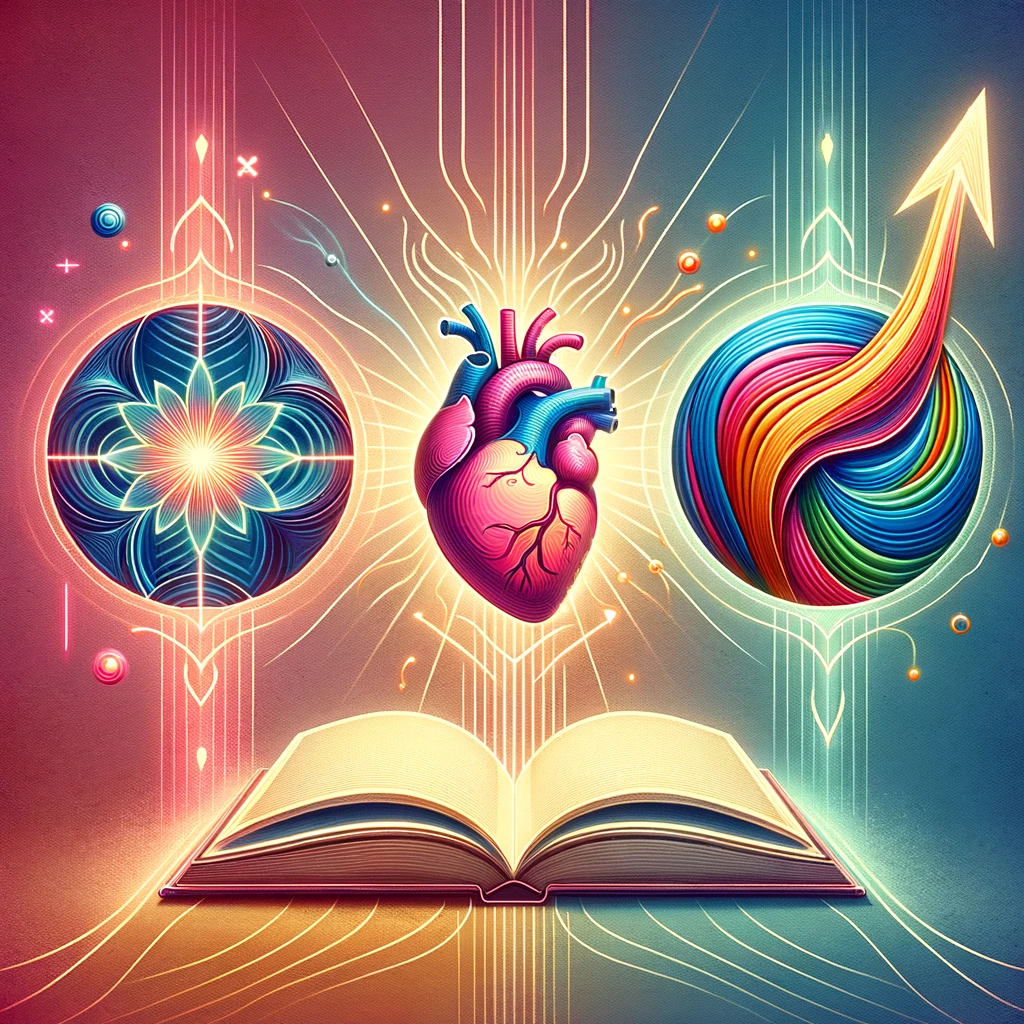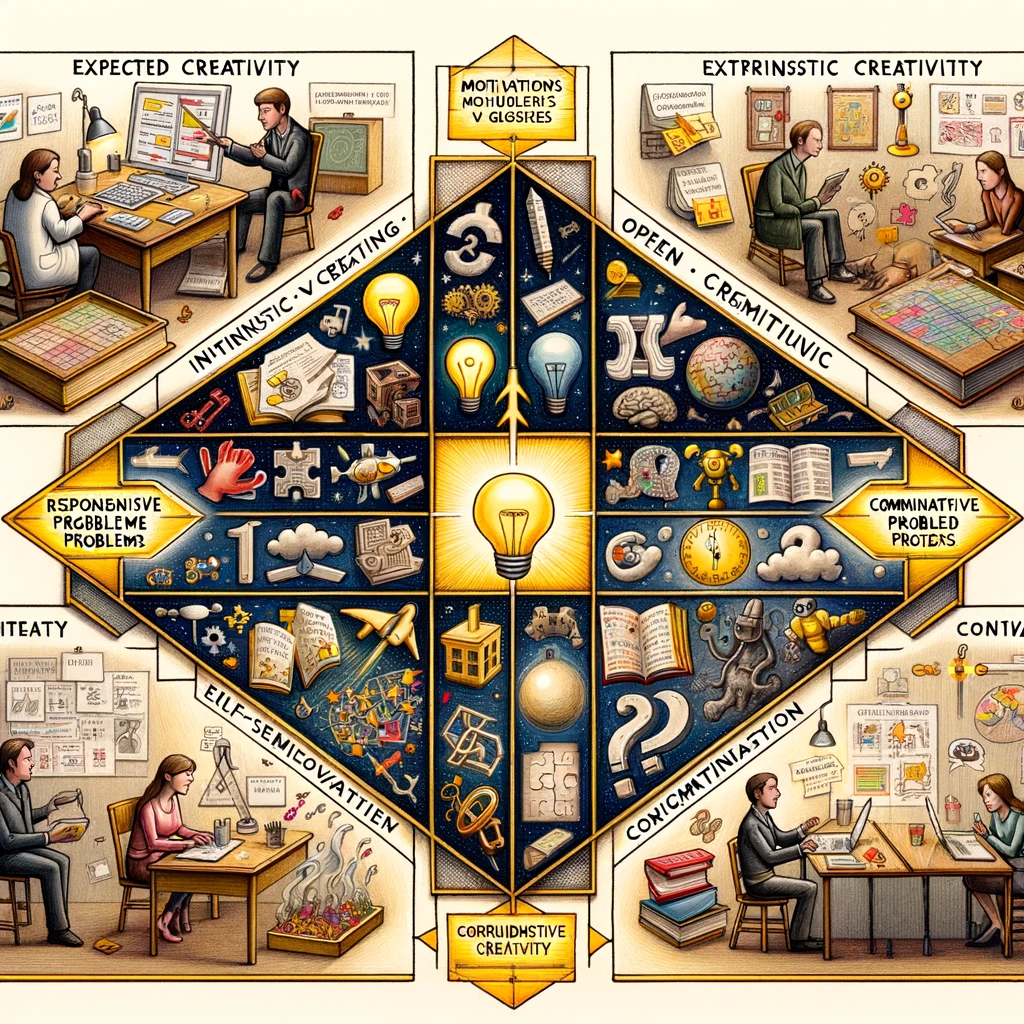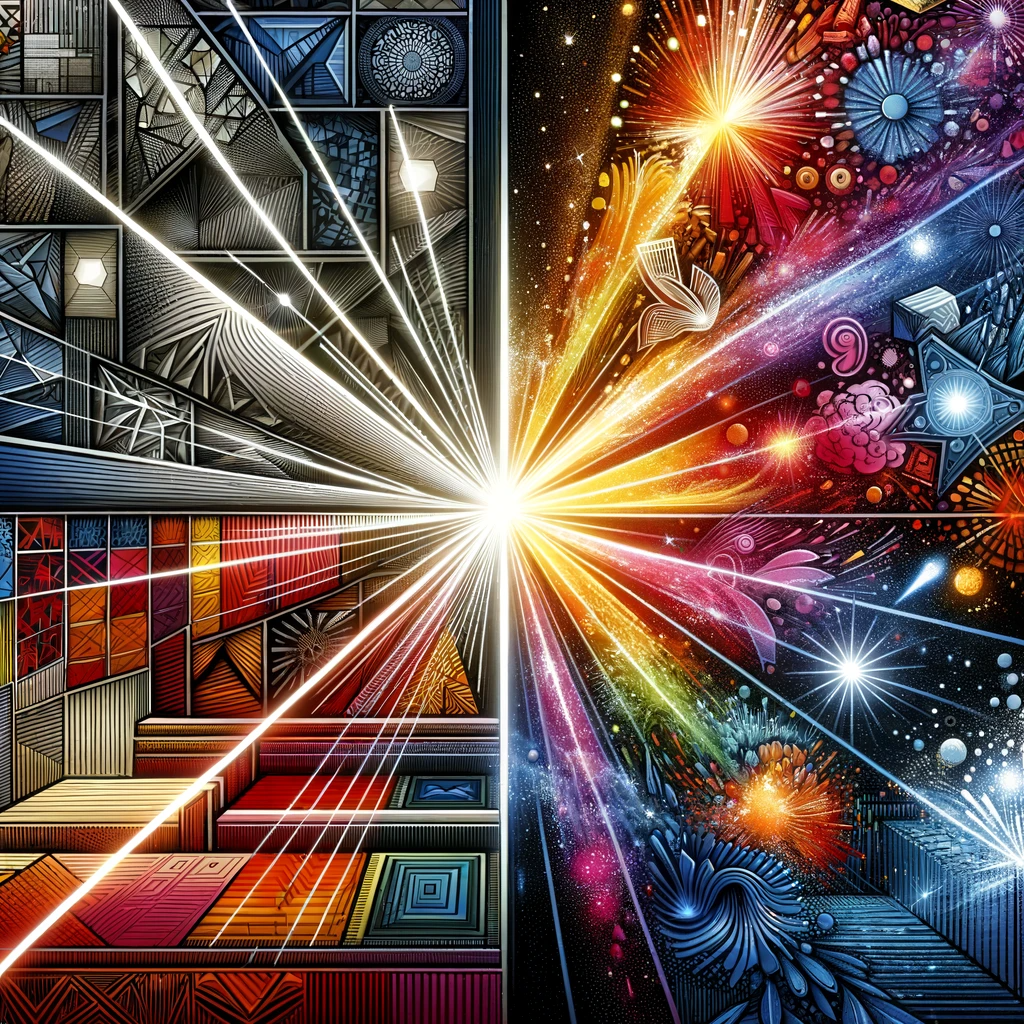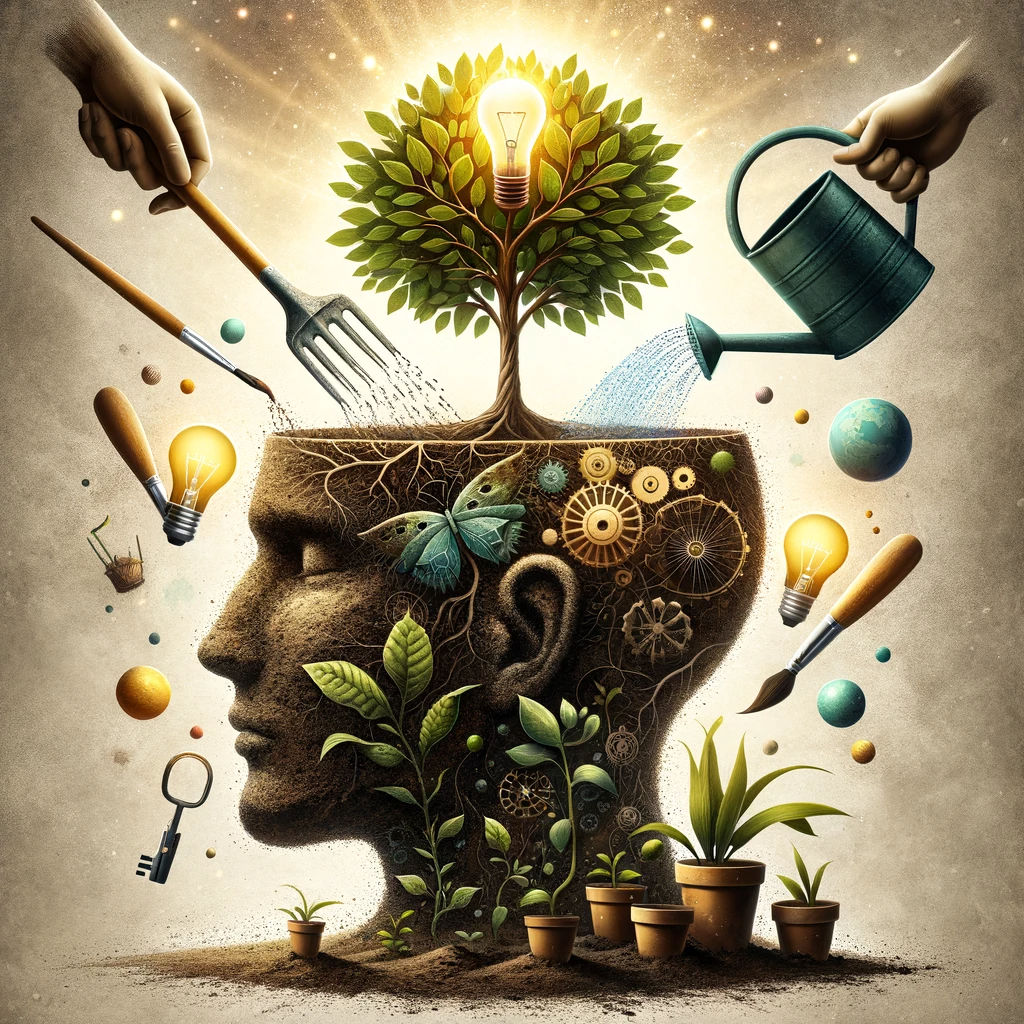- Elise
- November 28, 2023
- Uncategorized
Fostering Creativity in the Classroom: Part 5, Attributes of Creativity
What is Creativity?
If you are just joining me, this is the fifth installment in my inquiry into Creativity, in which we will explore the Attributes of Creativity. Over the previous posts, I provided my rationale, introduced the creative process, and outlined how creativity is thought about in school settings. In the previous essay, I defined the word creativity, fleshing out its components and highlighting the most significant qualities. In this article, I answer the question: “How do people generate novel and valuable ideas?”
Characteristics of Creative Thinkers
Scholars like Mihaly Csikszentmihalyi, Robert Sternberg, and Teresa Amabile, among others, have explored the cognitive, personality, and environmental factors that contribute to creative thinking. People who have certain attributes, such as risk-taking and a tolerance of ambiguity, are more likely to be creative. Most of these, such as curiosity and resourcefulness, are self-explanatory, but I’d like to highlight a few.

Open-Mindedness
Creative individuals tend to be open-minded and are receptive to new ideas, perspectives, and possibilities. They are willing to explore unconventional paths and consider viewpoints that may differ from their own. Adaptability means that a person can thrive in diverse and evolving environments.
Resilience
Creative people are often comfortable with uncertainty and can navigate through unfamiliar situations. Creativity often involves experimentation and the possibility of failure. Resilient individuals are undeterred by setbacks and use them as opportunities for learning and growth.
Persistence
Empathy helps creative individuals understand the perspectives and needs of others, leading to solutions that address real-world challenges. Creative endeavors often require persistence and dedication. Creative individuals are willing to invest time and effort to refine their ideas and bring them to fruition.
Putting It All Together
Creative strengths like these, when nurtured and cultivated, contribute to an individual’s ability to think innovatively, problem-solve effectively, and generate novel ideas across various domains.
Examining three prominent theoretical frameworks—The Componential Model, the Investment Theory, and the Evolving Systems Approach— will shed light on the factors that contribute to the creative process. By analyzing these perspectives, we gain a deeper understanding of the cognitive, motivational, and contextual aspects of creativity.
Frameworks to Understand Creativity
The Componential Model
The Componential Model posits a comprehensive view of creativity, identifying six key elements that collectively shape the creative process. This model underscores the significance of both creativity-relevant processes and skills in addition to motivation. It is a versatile framework adaptable to diverse domains, providing insights into creativity’s cognitive dimensions.
The identified elements include domain-relevant skills, creativity-relevant processes, intrinsic motivation, synergistic external motivations, work orientation, and positive affect. Although its complexity may pose challenges in practical application, its emphasis on cognitive and motivational factors contributes to a holistic understanding of creativity.

The Investment Theory
The Investment Theory highlights the creator’s ability to identify undervalued ideas, persuade others of their worth, and move on to new projects. This theory underscores the importance of intelligence, motivation, personality, knowledge, thinking styles, and the environment. Effective communication plays a pivotal role in advocating for ideas. However, it may not fully address the challenges of unacknowledged ideas and might not align well with educational contexts. Despite its focus on recognizing and advocating for ideas, it offers valuable insights into the role of communication in creativity.
The Evolving Systems Approach
The Evolving Systems Approach emphasizes the role of curiosity-triggering questions in fostering creative pursuits that are genuinely passionate and personally meaningful. Csikszentmihalyi’s concept of flow is central to this perspective, portraying intensely engaged moments of absorption and satisfaction. This approach acknowledges the driving forces of internal motivation and interests in the creative process. Nevertheless, it may lack concrete guidance on how to trigger curiosity and create flow experiences across various contexts. It also overlooks external influences on creativity.
Motivation, Affect and Knowledge
In all three models, motivation, affect, and knowledge play significant roles, influencing how individuals generate ideas, approach challenges, and produce innovative outcomes. Motivation refers to the internal or external factors that drive individuals to engage in specific activities or pursue certain goals. In the context of creativity, motivation plays a crucial role in determining the extent to which individuals are willing to invest time, effort, and resources into their creative endeavors.
Intrinsic vs. Extrinsic Motivation
When individuals are intrinsically motivated, they engage in creative activities because they find them inherently enjoyable and personally rewarding. This type of motivation often leads to more original and meaningful creative outcomes, as individuals are driven by their genuine interest and passion. All three theories highlight the significance of intrinsic motivation in cultivating creativity. External factors, such as rewards, recognition, or social approval, can also drive creativity. While extrinsic motivation can lead to creative output, it might not be as sustainable or as likely to result in truly innovative ideas compared to intrinsic motivation.
Positive vs. Negative Emotions
Affect refers to one’s emotional state. Positive Emotions might be feelings of happiness, excitement, and curiosity that can enhance creative thinking. Positive emotions broaden cognitive processes, enabling individuals to think more flexibly and consider a wider range of ideas. They can also contribute to a more open and exploratory mindset. Contrary to what one might assume, negative emotions like frustration, disappointment, or even sadness can also fuel creativity. These emotions can lead individuals to engage in deeper reflection, problem-solving, and a search for novel solutions as a way to cope with challenges. Additionally, the Investment Theory and the Evolving Systems Approach recognize the role of personal satisfaction and positive affect.
Domain Expertise vs. Diverse Knowledge
Knowledge serves as the foundation for creativity, providing a framework from which innovative ideas can emerge. A deep understanding of a particular field or domain (also called domain expertise) is crucial for generating creative ideas within that context. Domain knowledge provides the necessary foundation to identify gaps, question assumptions, and propose novel solutions. Cross-disciplinary or diverse knowledge can lead to novel connections between seemingly unrelated concepts.

Individuals with knowledge spanning multiple areas can draw inspiration from various sources, resulting in innovative combinations. Creativity often involves recognizing the value of unexpected connections or chance discoveries. A solid base of knowledge increases the likelihood of recognizing the significance of these seemingly random occurrences. The Componential Model and the Investment Theory incorporate cognitive elements as critical components of the creative process.
The Matrix Model
The three theories described above all emphasize the importance of intrinsic motivation. The Matrix Model complements and intersects with the three theories by providing a categorization framework that can be aligned with their key concepts. It helps relate the motivations (intrinsic vs. extrinsic) and problem types (open vs. closed) to the broader themes explored in the Componential Model, the Investment Theory, and the Evolving Systems Approach, offering an additional lens through which to understand creativity. Combining Reason and Content into 4 possible types of creativity results in proactive creativity, expected creativity, contributory creativity, and responsive creativity (Unsworth, 2001).

- Expected Creativity is brought about via an external expectation but with a self-discovered problem. For example, a scientist who chooses their own topic of research but is by nature of their job prompted to engage in that research.
- Proactive Creativity is when individuals driven by internal motivators, actively search for problems to solve. This is the type that we seem to value the most in our culture… our “geniuses” like Picasso, Steve Jobs, Elon Musk, and Einstein.
- Responsive Creativity is when there is a specified problem that a participant solves within an organization or situation. Individuals have the least control over problem solving choice.
- Contributory Creativity occurs when individuals are self-determined and based upon a problem clearly formulated by others. Individuals who elect to engage in creativity to help solve problems with which they are not directly involved.

Expected and Proactive Creativity involve scanning and defining skills, while responsive and contributory creativity are influenced by curiosity and the ability to identify and frame problems. Proactive and Contributory creativity involve communication, displaying unique understanding, knowledge, and the ability to persuade others of one’s thinking. This implies that the type of creativity is highly dependent on other skills, some of which are neither taught nor valued in our educational system.
Creativity Can Be Learned
Creating an educational environment that aligns with the elements contributing to creativity and the explanations of the creative process provided by these theories involves fostering a culture that supports both individual and collaborative creative thinking. The Creative Process and the attributes of creativity necessarily overlap and will be served by the same types of activities and setting. We would want to create an environment that reflects and accommodates the elements contributing to creativity and the explanations of the creative process.
Instead of treating creativity merely as a characteristic of a person, we can effectively boost creativity by taking specific actions. Students need to know what these actions are and how to practice them. Some of these activities are: risk-taking, thinking divergently, being curious and tolerant of ambiguity. Risk-taking in the context of the creative process refers to the willingness and ability of individuals to step outside of their comfort zones, challenge established norms, and explore new, uncharted territories in their creative work. It involves pushing the boundaries, embracing uncertainty, and potentially facing failure or unexpected outcomes in pursuit of innovative and original ideas.
Creativity often thrives when individuals are willing to take risks, as it encourages them to break free from conventional thinking patterns and experiment with different approaches. Coming up with ideas (ideation) can result in either convergent thinking or divergent thinking. Convergent thinking pursuing the “correct” answer which fits an expectation or convention. Divergent thinking involves generating novel solutions and ideas, and denotes creative potential.

Having creative potential may lead to a creative performance, but is not guaranteed. Creativity is actually producing or developing original work, theories, techniques, or thoughts. “The best predictor of creativity is openness to new experiences” (Weir, 2022); we can develop this trait by encouraging curiosity and tolerance of the unusual or unknown.
The Matrix Model is a very useful tool for educators, implying that creative thinking differs based on the type of task being performed and the reasons for engaging in it. Creativity is more constrained when students are engaging in creative thinking for external reasons and are doing tasks or problems that are more closed (that is, ‘externally imposed’).
Responsive creativity may be “less creative” than proactive creativity. This may be a useful way for us to evaluate the quality of the assignments and activities that we use. More importantly, it is a way to adjust our expectations: if we provide a closed problem (most frequently done in class), then it is likely to elicit less creative responses. Open-ended problems encourage students to apply their knowledge to real-world scenarios, think critically, and explore creative solutions. By engaging in these types of challenges, students can develop a deeper understanding of concepts while honing their problem-solving and critical thinking skills.
Nurturing Creativity in the Classroom
To fellow educators, it’s crucial to recognize that creativity is indeed a skill that can be nurtured. It’s closely tied to how students approach various situations, how they respond when faced with the unfamiliar, their willingness to view matters from different perspectives, and their courage to explore uncharted territories, question norms, and embrace uncertainty. Rather than a static trait, creativity is an outcome of actions taken.
In our role, we can liken creativity to a muscle—one that strengthens with regular exercise. Guiding our students to understand that creativity thrives when put into practice is essential. Encourage them to adopt the behaviors of creative individuals, as this can significantly enhance their creative prowess. As educators, we’re aware that those who are hailed for their creativity often showcase common attributes.

By fostering an environment that values diverse thinking, risk-taking, and experimentation, we can play a pivotal role in instilling these characteristics in our students, setting them on a path towards realizing their creative potential. Now that we know the Attributes of Creativity we can do our best to incorporate them into our curriculum.
After exploring the creative process, sketching a picture of the educational environment, and describing creativity in terms of its attributes, stages of development, and characteristics, the next questions seem obvious: How do we evaluate creative products? How do we determine the level of creativity possessed by an individual? Is there a test that allows us to predict who is creative? I will tackle those questions in the next installment.
I hope that this has been interesting to you so far! Please submit your own observations, methods, and questions in the comments section. I am eager to hear what you think!
Like this article? Please share to help build our community.
References
“21st Century Skills Standards Rubrics.” 2023, OSPI. www.k12.wa.us/file/21stcenturyskillsstandardsrubricdoc. Accessed 25 Aug. 2023.
Alabbasi, A. M., Paek, S. H., Kim, D., & Cramond, B. “What do educators need to know about the torrance tests of creative thinking: A comprehensive review.” Frontiers in Psychology, 2022. https://doi.org/10.3389/fpsyg.2022.1000385.
Amabile, T. M. Creativity in Context: Update to the Social Psychology of Creativity. Westview Press, 1996.
Amabile, T. M. “The Social Psychology of Creativity: A Componential Conceptualization.” Journal of Personality and Social Psychology, vol. 45, no. 2, 1983, pp. 357-376. [DOI: 10.1037/0022-3514.45.2.357](DOI: 10.1037/0022-3514.45.2.357).
Battelle for Kids. “Battelle for Kids.” 2020, www.battelleforkids.org/networks/p21/frameworks-resources.
Beghetto, R. A. “Creativity in the classroom.” In J. C. Kaufman & R. J. Sternberg (Eds.), The Cambridge handbook of creativity, 2010, pp. 447–463. Cambridge University Press. https://doi.org/10.1017/CBO9780511763205.027.
Boldt G. “Artistic creativity beyond divergent thinking: Analysing sequences in creative subprocesses.” Thinking Skills and Creativity, 2019;34:100606.
Brookhart, S. M. How to assess higher-order thinking skills in your classroom. ASCD, 2010.
Brookhart, S. M. “Assessing Creativity”. ASCD, vol. 70, no. 5, 2013. https://www.ascd.org/el/articles/assessing-creativity. Accessed 1 Jan 2023.
Craft, A. Creativity across the Primary Curriculum: Framing and Developing Practice. Routledge, 2000.
Cropley, A. J., & Cropley, D. H. “Fostering creativity in engineering undergraduates.” International Journal of Engineering Education, vol. 24, no. 2, 2008, pp. 283-294.
Csikszentmihalyi, M. Creativity: Flow and the Psychology of Discovery and Invention. HarperCollins, 1996.
Davies, L.M., Newton, L. D. & Newton, D. P. “Creativity as a twenty-first-century competence: an exploratory study of provision and reality.” Education 3-13, vol. 46, no. 7, 2018, pp. 879-891. [DOI: 10.1080/03004279.2017.1385641](DOI: 10.1080/03004279.2017.1385641).
Dewey, John. Democracy and Education: An Introduction to the Philosophy of Education. The Macmillan Company, 1916.
Dictionary of Creativity: Terms, Concepts, Theories & Findings in Creativity Research / Compiled and edited by Eugene Gorny. Netslova.ru, 2007. https://creativity.netslova.ru/Evolving_systems_approach.html.
Ericsson, K. A. “The Influence of Experience and Deliberate Practice on the Development of Superior Expert Performance.” In K. A. Ericsson, N. Charness, P. J. Feltovich, & R. R. Hoffman (Eds.), The Cambridge Handbook of Expertise and Expert Performance, 2006, pp. 683-703. Cambridge University Press.
“Framework for 21st Century Learning Definitions.” Battelle For Kids, 2019.
Gardner, H. Multiple Intelligences: The Theory in Practice. Basic Books, 1993.
Gardner, Howard. Frames of Mind: The Theory of Multiple Intelligences. Basic Books, 1983.
Gibson, J. J. “The Theory of Affordances.” In R. Shaw & J. Bransford (Eds.), Perceiving, Acting, and Knowing: Toward an Ecological Psychology, 1977, pp. 67-82. Lawrence Erlbaum Associates.
Glăveanu, V. P. “Rewriting the Language of Creativity: The Five A’s Framework.” Review of General Psychology, vol. 17, no. 1, 2013, pp. 69–81. https://doi.org/10.1037/a0029528.
Grigorenko, Elena L. et al. “Something New in the Garden: Assessing Creativity in Academic Domains.” Psychology Science 50, 2008, pp. 295.
Guilford, J. P. “Creativity.” American Psychologist, vol. 5, no. 9, 1950, pp. 444-454. [DOI: 10.1037/h0063487](DOI: 10.1037/h0063487).
Kaufman, J. C., & Beghetto, R. A. “Beyond Big and Little: The Four C Model of Creativity.” Review of General Psychology, vol. 13, no. 1, 2009, pp. 1-12. [DOI: 10.1037/a0013688](DOI: 10.1037/a0013688).
Kohn, Alfie. Punished by Rewards: The Trouble with Gold Stars, Incentive Plans, A’s, Praise, and Other Bribes. Mariner Books, 2000.
Kumar M, Roy S, Bhushan B, Sameer A. “Creative problem solving and facial expressions: A stage based comparison.” PLoS ONE, vol. 17, no. 6, 2022. https://doi.org/10.1371/journal.pone.0269504.
Land, G. and Jarman, B. Breaking Point and Beyond. San Francisco: HarperBusiness, 1993.
Lubart, TI. “Models of the creative process: Past, present and future.” Creativity Research Journal, 2001;13(3–4):295–308.
Munro, John. “Insights into the creativity process.” 2023, https://students.education.unimelb.edu.au/selage/pub/readings/creativity/UTC_creativity_tasks_.pdf. Accessed 22 Aug 2023.
Nazzal LJ, Kaufman JC. “The relationship of the quality of creative problem solving stages to overall creativity in engineering students.” Thinking Skills and Creativity, 2020;38:100734.
“NGSS Hub”. Ngss.Nsta.Org, 2023. Accessed 25 Aug 2023.
Pink, Daniel H. Drive: The Surprising Truth About What Motivates Us. Riverhead Books, 2011.
Punyamishra.Com. https://punyamishra.com/wp-content/uploads/2016/08/Runco-interview-Tech-Trends-2016.pdf. Accessed 21 June 2023.
Rieck, Dean. “Do You Have These 11 Traits Of Highly Creative People?” Copyblogger, 2009. https://copyblogger.com/highly-creative-people/. Accessed 25 Aug 2023.
Rhodes, M. “An Analysis of Creativity.” Phi Delta Kappan, vol. 42, no. 7, 1961, pp. 305-310.
Robinson, Ken. “Do Schools Kill Creativity?” TED, 2006, https://www.ted.com/talks/ken_robinson_do_schools_kill_creativity.
Roth, T., Conradty, C. & Bogner, F.X. “Testing Creativity and Personality to Explore Creative Potentials in the Science Classroom.” Res Sci Educ, vol. 52, 2022, pp. 1293–1312. https://doi.org/10.1007/s11165-021-10005-x.
Runco, M. A. “Creativity.” Annual Review of Psychology, vol. 55, 2004, pp. 657-687. [DOI: 10.1146/annurev.psych.55.090902.141502](DOI: 10.1146/annurev.psych.55.090902.141502).
Runco, M. A., & Bahleda, M. D. “Mini-c and Little-c Creativity.” Psychological Reports, vol. 53, no. 3, 1983, pp. 895-896. [DOI: 10.2466/pr0.1983.53.3.895](DOI: 10.2466/pr0.1983.53.3.895).
Runco, M. A., & Pritzker, S. R. Encyclopedia of Creativity. Academic Press, 1999.
Sadler-Smith, E. “Wallas’ Four-Stage Model of the Creative Process: More Than Meets the Eye?” Creativity Research Journal, vol. 27, no. 4, 2015, pp. 342-352. [DOI: 10.1080/10400419.2015.1087277](DOI: 10.1080/10400419.2015.1087277).
Sandor, Nick. “The 5 A’s Of Creativity”. 2014, https://prezi.com/memogu796dat/the-5-as-of-creativity/. Accessed 23 Aug 2023.
Sawyer, RK. “How Artists Create: An empirical study of MFA painting students.” The Journal of Creative Behavior, vol. 52, no. 2, 2016, pp. 127–41.
Sawyer, R. K. Explaining Creativity: The Science of Human Innovation. Oxford University Press, 2006.
Shalaby, Carla. Troublemakers: Lessons in Freedom from Young Children at School. The New Press, 2017.
Shively, Candace. “Teachersfirst – Dimensions Of Creativity: A Model To Analyze Student Projects.” 2022, https://www.teachersfirst.com/ISTECRe8/index.cfm. Accessed 2 Jun 2022.
Simonton, D. K. Creativity in Science: Chance, Logic, Genius, and Zeitgeist. Cambridge University Press, 1995.
Simonton, D. K. “Creative Product and Creative Process in Science.” In P. E. Vernon (Ed.), Creativity, 1995, pp. 280-296. American Psychological Association.
Simonton, D. K. Origins of Genius: Darwinian Perspectives on Creativity. Oxford University Press, 1999.
Smith, J. K., & Smith, L. F. “Educational creativity.” In J. C. Kaufman & R. J. Sternberg (Eds.), The Cambridge handbook of creativity, 2010, pp. 250–264. Cambridge University Press. https://doi.org/10.1017/CBO9780511763205.016.
Sternberg, R. J. Wisdom, Intelligence, and Creativity Synthesized. Cambridge University Press, 2003.
Sternberg, R. J., & Lubart, T. I. Defying the Crowd: Cultivating Creativity in a Culture of Conformity. Free Press, 1995.
“Teachersfirst – Dimensions Of Creativity: A Model To Analyze Student Projects.” 2023, https://www.teachersfirst.com/ISTECRe8/index.cfm. Accessed 1 Jan 2023.
Thomas, M’Balia. “The Everyday Creativity of Authentic Classroom Assessments.” 2023, https://files.eric.ed.gov/fulltext/EJ1304584.pdf. Accessed 5 Feb 2023.
Torrance E. P. Torrance tests of creative thinking: Norms technical manual (Research Edition). Princeton: Personnel Press, 1966.
Wallas, Graham. “The Art of Thought.” Journal of Philosophy, Psychology and Scientific Methods, vol. 23, no. 6, 1926, pp. 145-151. JSTOR.
Wiggins, Grant. “On Assessing for Creativity: Yes You Can, and Yes You Should.” Authentic Education, 3 Feb. 2012, authenticeducation.org/on-assessing-for-creativity-yes-you-can-and-yes-you-should/.
Wiggins, Grant. Rubric for Creativity. 2023, https://grantwiggins.files.wordpress.com/2012/02/creative.pdf. Accessed 1 Jan 2023.
Weir, Kirsten. “The Science behind Creativity.” Apa.org, 1 Apr. 2022, www.apa.org/monitor/2022/04/cover-science-creativity.
Unsworth, Kerrie. “Unpacking Creativity.” Academy of Management Review, vol. 26, no. 2, 2001, pp. 286-297. https://eprints.qut.edu.au/3028/1/3028_1.pdf. Accessed 22 Aug. 2023.


